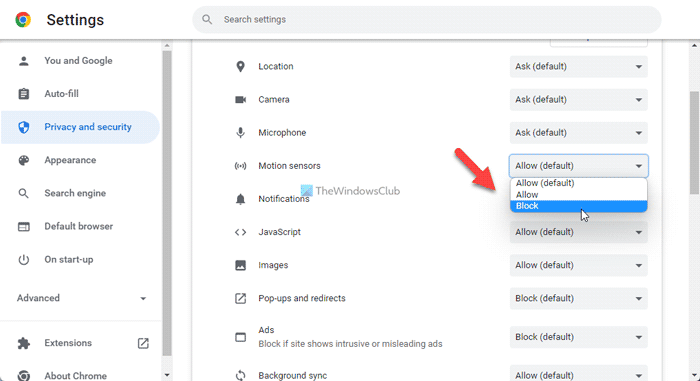How to allow or block Sensors for specific sites on Chrome
To allow or block Motion Sensors for specific sites on Chrome, follow these steps: To learn more about these steps, continue reading. First, you need to open the desired website and click on the lock icon visible in the address bar. Then, click on the Site settings option. It opens the panel where you can find all the permissions you can allow or block for a specific website. You need to find the enlisted sensors. For example, you can find the Motion sensors.
You need to expand the corresponding drop-down list and choose the Allow option to enable and the Block option to disable the sensor for that specific website.
How to allow or block sensors for specific sites on Chrome using Group Policy
To allow or block sensors for specific sites on Chrome using Group Policy, follow these steps: Let’s check out these steps in detail. To get started, you need to open the Local Group Policy Editor. For that, press Win+R > type gpedit.msc and hit the Enter button. Then, navigate to this path: User Configuration > Administrative Templates > Google > Google Chrome > Content settings Here you can find two settings:
Allow access to sensors on these sitesBlock access to sensors on these sites
If you want to allow the sensors on a specific website, you need to double-click on the Allow access to sensors on these sites setting and choose the Enabled option.
Then, click the Show button and enter the website URL. Click the OK button to save the change. Similarly, if you want to block sensors on a particular website, you need to double-click on the Block access to sensors on these sites setting and do the same as above. Finally, restart the Google Chrome browser to apply the change.
How to enable or disable sensors on specific sites on Chrome
To enable or disable sensors on specific sites on Chrome, follow these steps: Let’s delve into these steps in detail. First, press Win+R > type regedit > click the OK button and click on the Yes option to open the Registry Editor on your computer. Then, go to this path: Right-click on Google > New > Key and name it Chrome.
Then, right-click on Chrome > New > Key. If you want to allow specific sites, enter the name as SensorsAllowedForUrls. If you want to block specific sites, enter the name as SensorsBlockedForUrls.
After that, right-click on this key > New > String Value and set the name as 1.
For your information, if you want to enlist multiple sites, you need to create another String Value named 2, and the list goes on. Once done, double-click on the String Value and enter the website URL. Click the OK button, close all windows, and restart your computer to get the change.
Chrome flag for Sensors
For your information, the flag for the Generic Sensor Extra Classes is located here: You can select Enabled or Disables based on your requirement. It enables an extra set of sensor classes based on Generic Sensor API, which exposes previously unavailable platform features, i.e. AmbientLightSensor and Magnetometer interfaces.
How do I allow only certain websites to block in Chrome?
Earlier, it was possible to allow or block certain websites in Chrome using the Local Group Policy Editor. However, that setting was deprecated a long time back. Now, you can follow this guide to allow or block websites in Chrome.
How do I unblock certain websites on Google Chrome?
If you have the old Group Policy template alongside the old version of Google Chrome, you can do that using the Local Group Policy Editor. For your information, the same thing can be done with the help of the Registry Editor as well. However, if you have used an extension or any other script, you can go through that to get the job done. That’s all! Hope these guides helped. Read: How to allow or block Google Chrome from opening PDF files externally.

